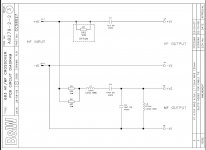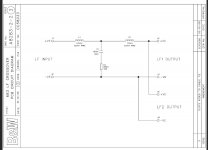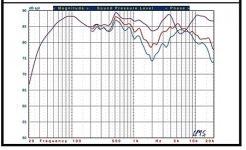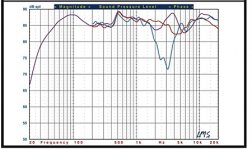I recently acquired a pair of these and like them, a lot . They replaced many far more expensive floorstanders in recent years that were without question more refined but ultimately nowhere near as enjoyable to listen to.
. They replaced many far more expensive floorstanders in recent years that were without question more refined but ultimately nowhere near as enjoyable to listen to.
While the 683s are not perfect by any means either, I think I`ll hang on to them for a while which has me wondering if a crossover component upgrade may be a cost effective tweak that`ll bring their performance up a notch.
I have read on a European forum that these speakers respond quite favorably to better crossover components.
My biggest "gripe" with these is that I find the top end a little too polite, lacking some bite and sparkle that I know exists.
The same could be said to a lesser degree about the FST midrange driver but I`m nitpicking on both accounts here.
I`m considering replacing the tweeter capacitors to one of these two:
Solen AGM470 - Silver Metallized Polypropylene Capacitors
or
Audyn KP SN Capacitor, 4.70mF 160Vdc. 2% Tolerance, Axial Lead
These are the two that are readily available and reasonably priced but I`d be open to other suggestions within the price range.
I`m also considering replacing the two generic resistors in the midrange band pass filter to some non inductive types while in there.
Depending on the results achieved by the HPF cap change, I may be tempted to replace the two midrange and woofer caps at a later point as they are of greater value and expense.
Your thoughts?
While the 683s are not perfect by any means either, I think I`ll hang on to them for a while which has me wondering if a crossover component upgrade may be a cost effective tweak that`ll bring their performance up a notch.
I have read on a European forum that these speakers respond quite favorably to better crossover components.
My biggest "gripe" with these is that I find the top end a little too polite, lacking some bite and sparkle that I know exists.
The same could be said to a lesser degree about the FST midrange driver but I`m nitpicking on both accounts here.
I`m considering replacing the tweeter capacitors to one of these two:
Solen AGM470 - Silver Metallized Polypropylene Capacitors
or
Audyn KP SN Capacitor, 4.70mF 160Vdc. 2% Tolerance, Axial Lead
These are the two that are readily available and reasonably priced but I`d be open to other suggestions within the price range.
I`m also considering replacing the two generic resistors in the midrange band pass filter to some non inductive types while in there.
Depending on the results achieved by the HPF cap change, I may be tempted to replace the two midrange and woofer caps at a later point as they are of greater value and expense.
Your thoughts?
Attachments
I'd go with the Audyn capacitors. In my experience, I've found the Audyns to be a little smoother sounding than Solens. An added bonus is price-wise, they're just a few cents more. The 150uF woofer shunt capacitor can safely be replaced with a high quality cap from Erse.
ERSE - Non-Polerized Electrolytic Capacitors
Replacing the resistors with non-inductive types like Lynx or Mills can't hurt.
ERSE - Non-Polerized Electrolytic Capacitors
Replacing the resistors with non-inductive types like Lynx or Mills can't hurt.
Last edited:
C3 is in series with an inductor and a resistance. Any concerns regarding parasitic properties with the capacitor are not reason to replace it.
The same goes for the mid resistor parasitic inductance. I wouldn't expect any difference on that alone.
Maybe measuring would find some issues to work on?
The same goes for the mid resistor parasitic inductance. I wouldn't expect any difference on that alone.
Maybe measuring would find some issues to work on?
Maybe measuring would find some issues to work on?
Measuring should reveal the crossover to be a somewhat idiosyncratic design implemented with quality components.
I have a pair of CM9s that are approximately the same thing as the 683. IIRC, the acoustic slope for the mid is roughly third order at the high end. Combined with a first order slope for the tweeter, this results in a strange radiation pattern, an M-shaped on-axis HF response and noticeable variation in response with vertical angle. See, for example, Stereophile's 683-S2 measurements.
I redesigned the mid and tweeter networks to move the crossover frequency down to 3 kHz with proper phase tracking etc which, IMO, sounds better. I would not expect replacing existing components with essentially the same thing to have a significant effect.
Here are a couple of measurements I came across.
The first is Violet curve: pseudo-anechoic response on the tweeter axis, averaged across a 30° horizontal window, combined with nearfield responses of the woofers and port). All measurements were taken at 1 meter.
Pseudo-anechoic response, off-center in the horizontal plane, at 45° (red) and 60° (blue).
The second,pseudo-anechoic response at 15° above (red) and 15° below (blue) the tweeter axis.
The first is Violet curve: pseudo-anechoic response on the tweeter axis, averaged across a 30° horizontal window, combined with nearfield responses of the woofers and port). All measurements were taken at 1 meter.
Pseudo-anechoic response, off-center in the horizontal plane, at 45° (red) and 60° (blue).
The second,pseudo-anechoic response at 15° above (red) and 15° below (blue) the tweeter axis.
Attachments
B&W are well known for their kooky crossover designs that like to fit into a simpler is better plus we like to cross 6-7" midrange drivers over way higher than they should
As you can see, the measurements above highlight this quite nicely and their 800 series is no better. B&W do however engineer nice cabinets and drivers. Upgrading crossover components is really pointless in my opinion and if any improvements are to be had going this route then they are going to be very minimal and mostly in your head.
What these really need is a crossover redesign and get that cover down to around 2kHz.
As you can see, the measurements above highlight this quite nicely and their 800 series is no better. B&W do however engineer nice cabinets and drivers. Upgrading crossover components is really pointless in my opinion and if any improvements are to be had going this route then they are going to be very minimal and mostly in your head.
What these really need is a crossover redesign and get that cover down to around 2kHz.
5th is absolutely correct in suggesting a filter redesign. I am afraid though that audiophiles will probably have some doubts, generally not understanding how could a manufacturer like B&W ever make a bad filter design solution while doing the rest od the loudspeaker in a truly remarkable fashion. It does not sound logical the DIYers would "know" better than the manufacturer, still they do in this very particular case.
It would appear that the general consensus here is that a network re design would be the ultimate solution and that merely changing the components using the existing values probably wouldnt be worth the effort.
That raises a question: why do these expensive high end components even exist?
It seems the lowly 683 isnt the only model that suffers from questionable filter design, I`ve seen similar references being made in higher end B&Ws which all incorporate "better" quality components.
That raises a question: why do these expensive high end components even exist?
It seems the lowly 683 isnt the only model that suffers from questionable filter design, I`ve seen similar references being made in higher end B&Ws which all incorporate "better" quality components.
Hey Michael,
There's ultimate, and there's better.
I wouldn't say it's not worth it. I think for $30 you could do some upgrades and learn some cool stuff.
I think for $30 you could do some upgrades and learn some cool stuff.
However, if you start to spend real money, a speaker analysis is sometimes in order.
I once spent a lot of money on coils and caps, and yeah, it all sounded better, but then I did a thorough analysis and realized the bass section was a mess, and that for half of what i spent in fancy upgrades, I should have just rethought the low pass filter and I would have had something much much better.
Best,
E
There's ultimate, and there's better.
I wouldn't say it's not worth it.
However, if you start to spend real money, a speaker analysis is sometimes in order.
I once spent a lot of money on coils and caps, and yeah, it all sounded better, but then I did a thorough analysis and realized the bass section was a mess, and that for half of what i spent in fancy upgrades, I should have just rethought the low pass filter and I would have had something much much better.
Best,
E
That raises a question: why do these expensive high end components even exist?
They exist because there will always be buyers of such products. Why miss a chance of profiting from it?
Hi all, you may find the information here very relevant to the discussion.
www.audioexcite.com >> Bowers & Wilkins 685 review part 1
www.audioexcite.com >> Bowers & Wilkins 685 review part 1
Every speaker is different, so we must do the homework:
Floorstanding Speaker Reviews:
Bowers & Wilkins 683 Loudspeaker Reviewed
OK, 2 metal basses in parallel, doubtless giving a low 4 ohm load. Third order filter. Nothing wrong with that.
Kevlar Mid, slightly notorious for harsh breakup around 4-5kHz. But a competent looking, fairly standard 4 element midrange crossover with a couple of ohms of attenuation in front.
A metal tweeter on a first order 4.7uF crossover, with some tiny 0.5R attenuation resistor. Ooh, don't like that much! Doesn't go loud comfortably.
If I haven't lost my touch, B&W cross quite high from the mid to the tweeter. 4kHz?
Excellent documentation from B&W as usual: B&W Group North America Service & Support - Home.
Like everyone is saying, I don't think the shortcomings are down to capacitor quality. Kevlar breakup from the mid, and that first-order tweeter crossover are going to add distortion at high volume.
As a diy project, I would work on the tweeter filter, and take the beating from the mid breakup. Make it higher 3rd. order, like (guesses...), 0.5R + 3.3uF, 0.15mH, 10uF, plus a 10R + 0.68uF Zobel across the tweeter terminals to take away the usual metallic brightness. Based on B&W's usual low impedance 4R tweeter. Probably swap polarity to negative and hope it comes in around 4kHz.
Otherwise, leave them as they are!
Floorstanding Speaker Reviews:
Bowers & Wilkins 683 Loudspeaker Reviewed
OK, 2 metal basses in parallel, doubtless giving a low 4 ohm load. Third order filter. Nothing wrong with that.
Kevlar Mid, slightly notorious for harsh breakup around 4-5kHz. But a competent looking, fairly standard 4 element midrange crossover with a couple of ohms of attenuation in front.
A metal tweeter on a first order 4.7uF crossover, with some tiny 0.5R attenuation resistor. Ooh, don't like that much! Doesn't go loud comfortably.
If I haven't lost my touch, B&W cross quite high from the mid to the tweeter. 4kHz?
Excellent documentation from B&W as usual: B&W Group North America Service & Support - Home.
Like everyone is saying, I don't think the shortcomings are down to capacitor quality. Kevlar breakup from the mid, and that first-order tweeter crossover are going to add distortion at high volume.
As a diy project, I would work on the tweeter filter, and take the beating from the mid breakup. Make it higher 3rd. order, like (guesses...), 0.5R + 3.3uF, 0.15mH, 10uF, plus a 10R + 0.68uF Zobel across the tweeter terminals to take away the usual metallic brightness. Based on B&W's usual low impedance 4R tweeter. Probably swap polarity to negative and hope it comes in around 4kHz.
Otherwise, leave them as they are!
B&W have actually managed to tame most of the issues with Kevlar and their drivers tend not to have severe breakup at all plus excellent motors and low distortion.
The only issues their speakers have is the high crossover points and simple crossovers with drivers that result in big issue both on and off axis.
Some people like the B&W sound but their design philosophy hardly results in a neutral sound.
The only issues their speakers have is the high crossover points and simple crossovers with drivers that result in big issue both on and off axis.
Some people like the B&W sound but their design philosophy hardly results in a neutral sound.
Hi Guys,
I'm new in this forum and I need Help for my 683. It's not about an upgrade but just a problem a drivers disassembling on the factory version.
After cleaning the black facade, the coating of which became, I put back the bass and midrange units, I was happy with the cosmetic result, but ....
I noticed during my listening that the midrange speaker of my 683 S1 does not work. When I opened and disassembled the midrange speaker I noticed that the two wires were touching.
I suspect that when reassembling the speaker, I inadvertently left the two wires (ones inside the driver) in contact and this caused a short circuit.
To understand what does not work, I inverted the two mediums and I concluded that it is the electronics (capacitor, Inductor or resistor ???) which is affected. And the medium speaker is fortunately safe.
I need you to tell me which components to change so that I order them and I change them by myself if it is not too difficult or by a local electronics engineer.
Thank you in advance for your help
I'm new in this forum and I need Help for my 683. It's not about an upgrade but just a problem a drivers disassembling on the factory version.
After cleaning the black facade, the coating of which became, I put back the bass and midrange units, I was happy with the cosmetic result, but ....
I noticed during my listening that the midrange speaker of my 683 S1 does not work. When I opened and disassembled the midrange speaker I noticed that the two wires were touching.
I suspect that when reassembling the speaker, I inadvertently left the two wires (ones inside the driver) in contact and this caused a short circuit.
To understand what does not work, I inverted the two mediums and I concluded that it is the electronics (capacitor, Inductor or resistor ???) which is affected. And the medium speaker is fortunately safe.
I need you to tell me which components to change so that I order them and I change them by myself if it is not too difficult or by a local electronics engineer.
Thank you in advance for your help
- Status
- This old topic is closed. If you want to reopen this topic, contact a moderator using the "Report Post" button.
- Home
- Loudspeakers
- Multi-Way
- Upgrading B&W 683 crossover



